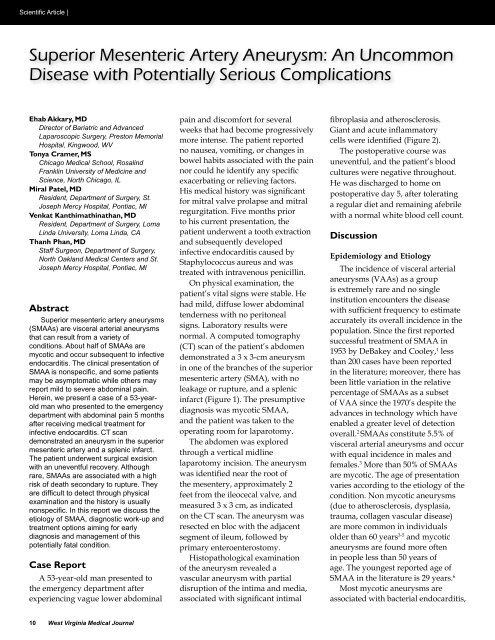Healthcare - West Virginia State Medical Association
Healthcare - West Virginia State Medical Association
Healthcare - West Virginia State Medical Association
Create successful ePaper yourself
Turn your PDF publications into a flip-book with our unique Google optimized e-Paper software.
Scientific Article |Superior Mesenteric Artery Aneurysm: An UncommonDisease with Potentially Serious ComplicationsEhab Akkary, MDDirector of Bariatric and AdvancedLaparoscopic Surgery, Preston MemorialHospital, Kingwood, WVTonya Cramer, MSChicago <strong>Medical</strong> School, RosalindFranklin University of Medicine andScience, North Chicago, ILMiral Patel, MDResident, Department of Surgery, St.Joseph Mercy Hospital, Pontiac, MIVenkat Kanthimathinathan, MDResident, Department of Surgery, LomaLinda University, Loma Linda, CAThanh Phan, MDStaff Surgeon, Department of Surgery,North Oakland <strong>Medical</strong> Centers and St.Joseph Mercy Hospital, Pontiac, MIAbstractSuperior mesenteric artery aneurysms(SMAAs) are visceral arterial aneurysmsthat can result from a variety ofconditions. About half of SMAAs aremycotic and occur subsequent to infectiveendocarditis. The clinical presentation ofSMAA is nonspecific, and some patientsmay be asymptomatic while others mayreport mild to severe abdominal pain.Herein, we present a case of a 53-yearoldman who presented to the emergencydepartment with abdominal pain 5 monthsafter receiving medical treatment forinfective endocarditis. CT scandemonstrated an aneurysm in the superiormesenteric artery and a splenic infarct.The patient underwent surgical excisionwith an uneventful recovery. Althoughrare, SMAAs are associated with a highrisk of death secondary to rupture. Theyare difficult to detect through physicalexamination and the history is usuallynonspecific. In this report we discuss theetiology of SMAA, diagnostic work-up andtreatment options aiming for earlydiagnosis and management of thispotentially fatal condition.Case ReportA 53-year-old man presented tothe emergency department afterexperiencing vague lower abdominalpain and discomfort for severalweeks that had become progressivelymore intense. The patient reportedno nausea, vomiting, or changes inbowel habits associated with the painnor could he identify any specificexacerbating or relieving factors.His medical history was significantfor mitral valve prolapse and mitralregurgitation. Five months priorto his current presentation, thepatient underwent a tooth extractionand subsequently developedinfective endocarditis caused byStaphylococcus aureus and wastreated with intravenous penicillin.On physical examination, thepatient’s vital signs were stable. Hehad mild, diffuse lower abdominaltenderness with no peritonealsigns. Laboratory results werenormal. A computed tomography(CT) scan of the patient’s abdomendemonstrated a 3 x 3-cm aneurysmin one of the branches of the superiormesenteric artery (SMA), with noleakage or rupture, and a splenicinfarct (Figure 1). The presumptivediagnosis was mycotic SMAA,and the patient was taken to theoperating room for laparotomy.The abdomen was exploredthrough a vertical midlinelaparotomy incision. The aneurysmwas identified near the root ofthe mesentery, approximately 2feet from the ileocecal valve, andmeasured 3 x 3 cm, as indicatedon the CT scan. The aneurysm wasresected en bloc with the adjacentsegment of ileum, followed byprimary enteroenterostomy.Histopathological examinationof the aneurysm revealed avascular aneurysm with partialdisruption of the intima and media,associated with significant intimalfibroplasia and atherosclerosis.Giant and acute inflammatorycells were identified (Figure 2).The postoperative course wasuneventful, and the patient’s bloodcultures were negative throughout.He was discharged to home onpostoperative day 5, after toleratinga regular diet and remaining afebrilewith a normal white blood cell count.DiscussionEpidemiology and EtiologyThe incidence of visceral arterialaneurysms (VAAs) as a groupis extremely rare and no singleinstitution encounters the diseasewith sufficient frequency to estimateaccurately its overall incidence in thepopulation. Since the first reportedsuccessful treatment of SMAA in1953 by DeBakey and Cooley, 1 lessthan 200 cases have been reportedin the literature; moreover, there hasbeen little variation in the relativepercentage of SMAAs as a subsetof VAA since the 1970’s despite theadvances in technology which haveenabled a greater level of detectionoverall. 2 SMAAs constitute 5.5% ofvisceral arterial aneurysms and occurwith equal incidence in males andfemales. 3 More than 50% of SMAAsare mycotic. The age of presentationvaries according to the etiology of thecondition. Non mycotic aneurysms(due to atherosclerosis, dysplasia,trauma, collagen vascular disease)are more common in individualsolder than 60 years 3-5 and mycoticaneurysms are found more oftenin people less than 50 years ofage. The youngest reported age ofSMAA in the literature is 29 years. 6Most mycotic aneurysms areassociated with bacterial endocarditis,10 <strong>West</strong> <strong>Virginia</strong> <strong>Medical</strong> Journal















